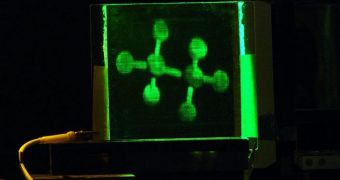Holograms are ideal when it comes to storing three-dimensional images, but the problem is they can only be written once. Rewritable holograms would greatly improve the storing capacity of future personal computers and could also provide with the technology to create three-dimensional displays. A team of U.S. researchers claim to have designed a new material that can record a holographic image, delete it and then rewrite it with a different image in just a couple of minutes.
However, some technological difficulties still remain, mostly related to increasing the refresh rate of a video relayed onto the holographic material. Nonetheless, researchers remain confident that, by improving the technology, they could obtain at least a 30 hertz refresh rate frequency. In much the same way a 3D image is stored onto a holographic plate, the new material could also perform as a high capacity hard drive that records data in layers through the depth of the hologram.
Holographic images are created by recording light reflected of a 3D object with the help of a laser that determines irreversible chemical changes into a photopolymeric material, thus, while viewing a holographic image, the observer is able to see the same light reflected from the real object, even while moving around in front of the hologram.
The fact that classical holograms are static disables a wide range of possible applications. On the other hand, rewritable holographic video displays work much in the same way as LCD displays, meaning that they scatter light through a liquid crystal filter, to create a holographic image that can be viewed only by the observer standing right in front of it.
Unlike read-only holographic plates, the liquid crystal devices can be forced to work at high refresh rates, in order to show multiple images in a shorter time interval. Once written, liquid crystal holographic plates hold an image for many hours if not rewritten.
The device has been developed by a team of researchers from the University of Arizona, led by optical engineer Nasser Peyghambarian, by modifying polymers into refracting light provided by a laser system. Because it can be chemically tunned to respond accurately to laser signals, it is also capable of producing a larger variety of colors than classical holographic plates.
Peyghambarian says that the writing process in performed with the help of two laser beams that act on the polymer in order to determine the appearance of an electrical charge which changes the refracting index in a designated spot. They can then delete the written information by lighting the material uniformly with a third laser beam.
Under a voltage of 9 kilovolts, the polymer material can be written once every 3 minutes, and will retain the image for 3 hours before fading away. The electric tension provides with the required energy to determine the appearance of a pool of electric charge, that greatly reduces the usual time necessary for recording a image with a simple laser system. Furthermore, to maintain the image for a longer time, a 4 kilovolt voltage level is applied.
Some scientists studying the phenomenon find it a bit hard to believe that the claim of the researchers from the University of Arizona is authentic. They argue that the material used in the experiment is at least 1000 times less sensitive to laser light than the polymers used traditionally in making static holograms, thus the input of power required for such an operation is high.
Another U.S. company specialized in implying holographic techniques for data storage, InPhase Technologies, says that the use of high levels of voltage may have applications for creating 3D displays, but, in data storage technology, such an amount of power would endanger the data storing process altogether. InPhase is expected to launch by the end of the year a holographic drive the size of a compact-disk, with a capacity of 300 gigabytes.

 14 DAY TRIAL //
14 DAY TRIAL //